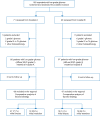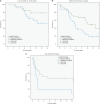Surgical resection versus watchful waiting in low-grade gliomas
- PMID: 28475680
- PMCID: PMC5834105
- DOI: 10.1093/annonc/mdx230
Surgical resection versus watchful waiting in low-grade gliomas
Abstract
Background: Infiltrating low-grade gliomas (LGG; WHO grade 2) typically present with seizures in young adults. LGGs grow continuously and usually transform to higher grade of malignancy, eventually causing progressive disability and premature death. The effect of up-front surgery has been controversial and the impact of molecular biology on the effect of surgery is unknown. We now present long-term results of upfront surgical resection compared with watchful waiting in light of recently established molecular markers.
Materials and methods: Population-based parallel cohorts were followed from two Norwegian university hospitals with different surgical treatment strategies and defined geographical catchment regions. In region A watchful waiting was favored while early resection was favored in region B. Thus, the treatment strategy in individual patients depended on their residential address. The inclusion criteria were histopathological diagnosis of supratentorial LGG from 1998 through 2009 in patients 18 years or older. Follow-up ended 1 January 2016. Making regional comparisons, the primary end-point was overall survival.
Results: A total of 153 patients (66 from region A, 87 from region B) were included. Early resection was carried out in 19 (29%) patients in region A compared with 75 (86%) patients in region B. Overall survival was 5.8 years (95% CI 4.5-7.2) in region A compared with 14.4 years (95% CI 10.4-18.5) in region B (P < 0.01). The effect of surgical strategy remained after adjustment for molecular markers (P = 0.001).
Conclusion: In parallel population-based cohorts of LGGs, early surgical resection resulted in a clinical relevant survival benefit. The effect on survival persisted after adjustment for molecular markers.
Keywords: astrocytoma; brain neoplasm; low-grade glioma; population based; survival; treatment outcome.
© The Author 2017. Published by Oxford University Press on behalf of the European Society for Medical Oncology.
Figures



Comment in
-
Surgery for patients with 'lower grade' glioma: putting assumptions, beliefs and convictions into perspective.Ann Oncol. 2017 Aug 1;28(8):1696-1697. doi: 10.1093/annonc/mdx295. Ann Oncol. 2017. PMID: 28637247 No abstract available.
References
-
- Sanai N, Chang S, Berger MS.. Low-grade gliomas in adults. J Neurosurg 2011; 1: 18. - PubMed
-
- Veeravagu A, Jiang B, Chang SD. et al. Biopsy versus resection for the management of low-grade gliomas. Cochrane Database Syst Rev 2013; 4: Cd009319. - PubMed
-
- Capelle L, Fontaine D, Mandonnet E. et al. Spontaneous and therapeutic prognostic factors in adult hemispheric World Health Organization Grade II gliomas: a series of 1097 cases. J Neurosurg 2013; 118: 1–12. - PubMed
-
- Smith JS, Chang EF, Lamborn KR. et al. Role of extent of resection in the long-term outcome of low-grade hemispheric gliomas. J Clin Oncol 2008; 26: 1338–1345. - PubMed
-
- Jakola AS, Myrmel KS, Kloster R. et al. Comparison of a strategy favoring early surgical resection vs a strategy favoring watchful waiting in low-grade gliomas. JAMA 2012; 308: 1881–1888. - PubMed
Publication types
MeSH terms
LinkOut - more resources
Full Text Sources
Other Literature Sources
Medical

